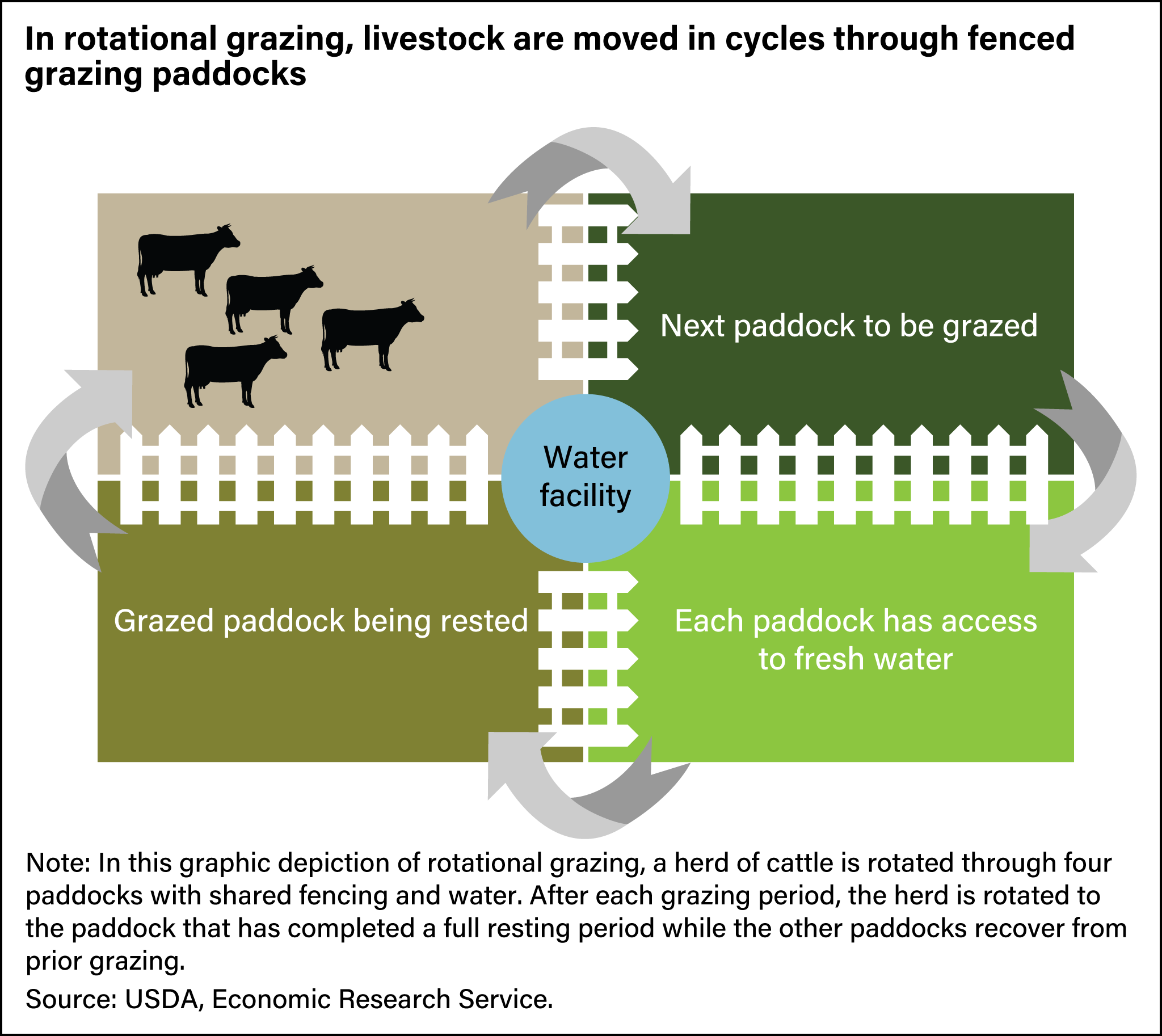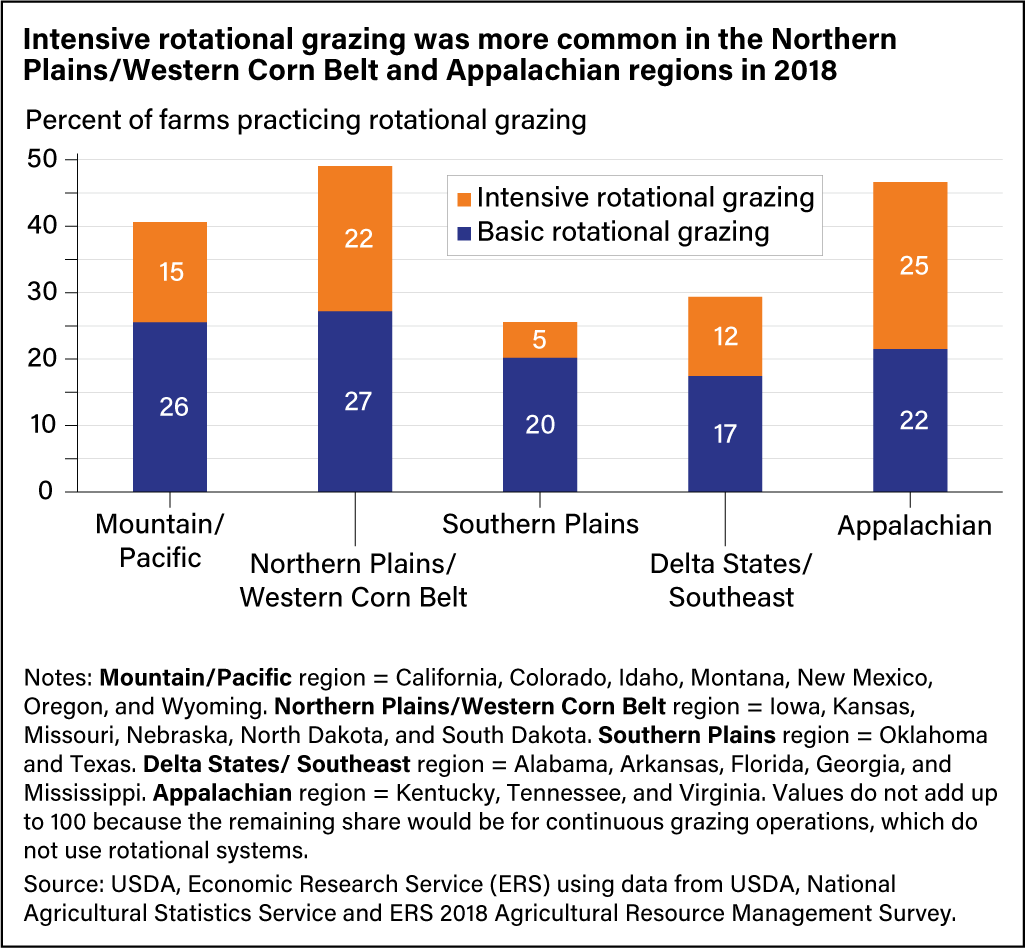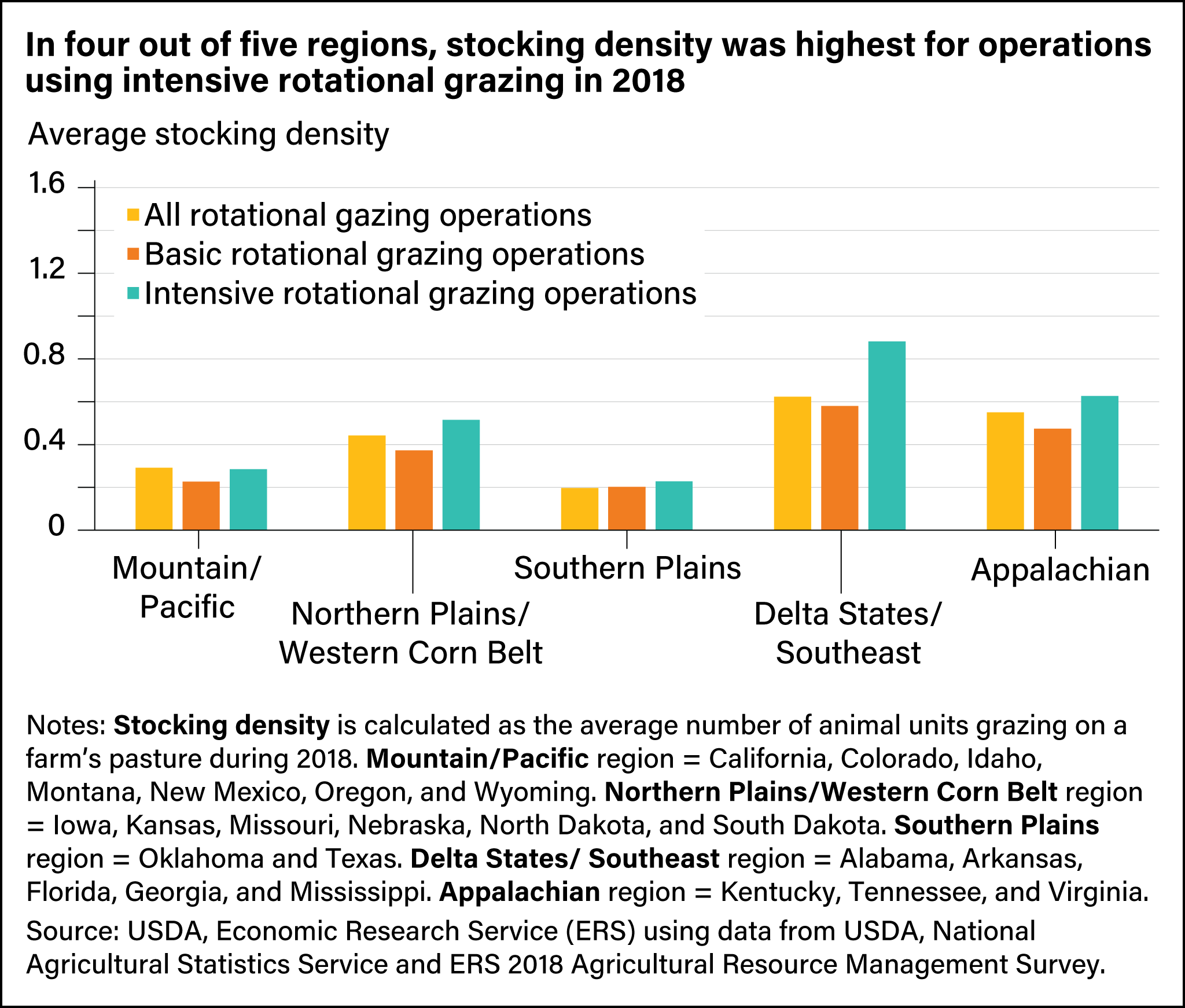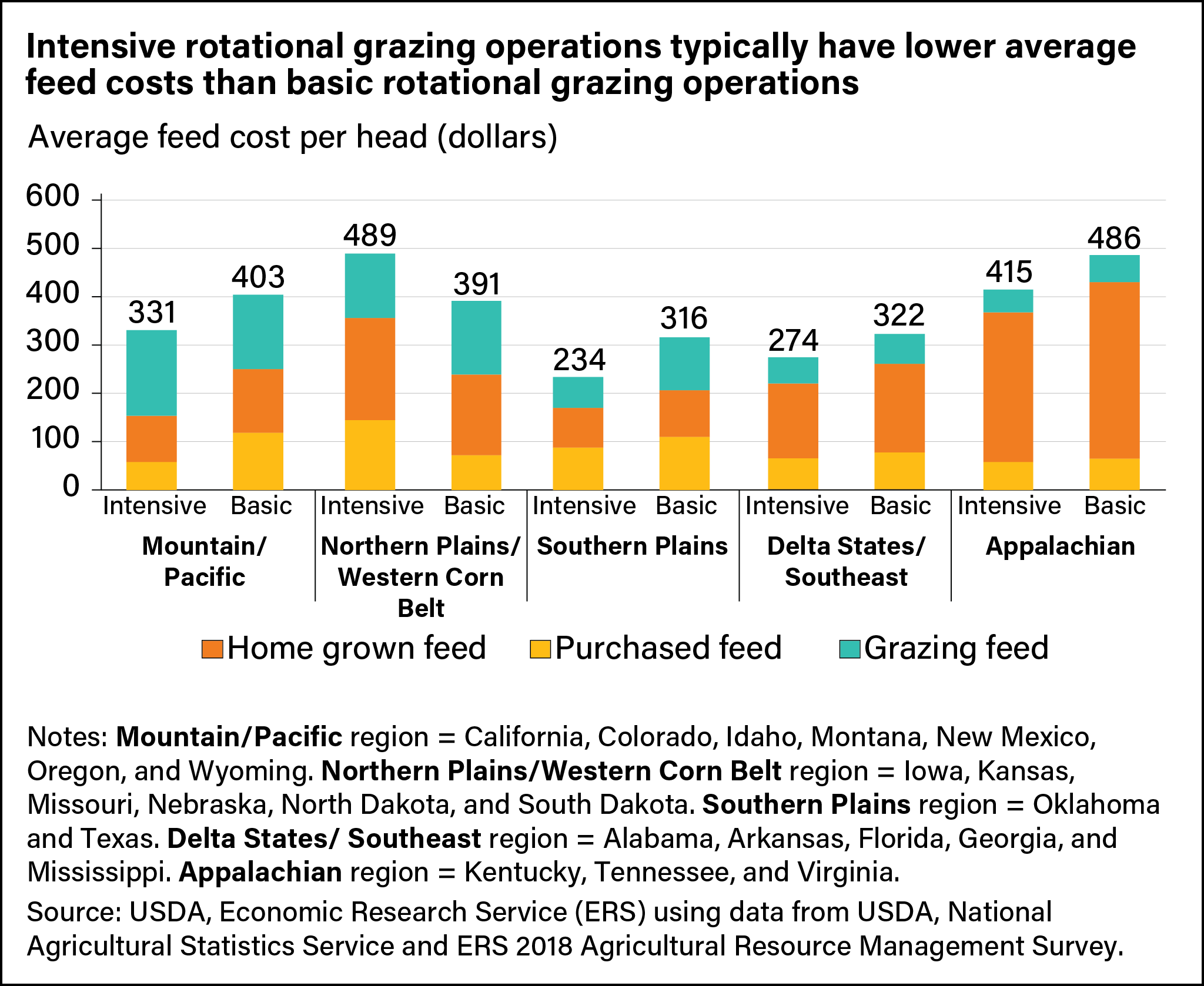
Study Examines How and Where U.S. Cow-Calf Operations Use Rotational Grazing
- by Christine Whitt and Steven Wallander
- 11/21/2022
Highlights
- USDA, Economic Research Service researchers examined rotational grazing practices of cow-calf operations, providing one of the first nationally representative datasets to describe rotational grazing systems. They defined two rotational systems—intensive and basic—according to length of grazing period.
- The adoption rate for basic rotational grazing is consistent across all regions, but the Appalachian and Northern Plains/Western Corn Belt regions had the highest adoption rate of intensive rotational grazing.
- Average feed costs are higher for basic rotational grazing than for intensive rotational grazing in all regions except the Northern Plains/Western Corn Belt.
Rotational grazing is a livestock management practice in which livestock are cycled through fenced grazing areas known as paddocks. Producers use it to manage the amount and quality of forage, animal health, and water quality. USDA, Natural Resources Conservation Service (NRCS) and other organizations promote rotational grazing as a way to support the environment and increase farm income. NRCS includes rotational grazing in its larger package of grazing practices and has long provided livestock-related financial assistance through USDA working lands programs such as the Environmental Quality Incentives Program (EQIP) and the Conservation Stewardship Program (CSP). In 2018, about 40 percent of all cow-calf operations adopted some form of rotational grazing, according to a recent study by USDA, Economic Research Service (ERS).
For their study, ERS researchers examined rotational grazing practices for operations with 20 or more cattle, using the 2018 Cattle and Calves Costs and Returns Report, Agricultural Resource Management Survey (ARMS) conducted by USDA, National Agricultural Statistics Service and ERS. The study resulted in one of the first nationally representative datasets to describe rotational grazing systems and variation in the adoption of systems for cow-calf operations in different regions. It provided a foundation for research on how past and present conservation program financial assistance affects grazing management. As conservation programs and other policies focus on expanding the adoption of prescribed grazing, the details highlighted by the study can provide a baseline for evaluating changes in grazing system management.
ERS researchers defined two types of rotational grazing based on the number of days a paddock is grazed in a single rotation:
- Intensive rotational grazing, using an average grazing period of 14 or fewer days per paddock.
- Basic rotational grazing, using an average grazing period of more than 14 days per paddock.
Continuous grazing systems do not involve rotating livestock through paddocks. The differences in average operation characteristics between those using continuous grazing, basic rotational grazing, and intensive rotational grazing systems provide insight into what drives decisions about which grazing system to adopt or outcomes of the grazing system decision.
The table below shows different aspects of cow-calf operations associated with basic and intensive rotational grazing systems and the continuous grazing system based on the survey data collected in this study. Operations that employ basic rotational grazing tend to be larger, with almost 2 1/2 times more pasture acreage, on average, than operations using intensive rotational grazing. Continuous grazing operations tend to use slightly less than twice as much pasture, on average, compared with intensive rotational grazing operations. Intensive rotational grazing operations have the highest average stocking density at 0.53 head per acre of grazing land, compared with the basic rotational grazing stocking density of 0.35 head per acre. One often-cited cost associated with implementing a rotational grazing system is the amount of time required for the operator to move cattle between paddocks, which can mean the operator potentially has less opportunity to work off the farm. However, data in the ERS study showed principal operators with rotational grazing systems worked significantly more hours off the farm in 2018 than principal operators who practiced continuous grazing.
| Basic rotational grazing | Intensive rotational grazing | Continuous grazing | |||||||||||||||||||
|
Average herd size (head) |
|
|
|
||||||||||||||||||
|
Average operation (acres) |
|
|
|
||||||||||||||||||
|
Average stocking density (head per grazing acre) |
|
|
|
||||||||||||||||||
|
Average total hours principal operators worked off the farm, 2018 |
|
|
|
||||||||||||||||||
|
Average cost of total feed per head (U.S. dollars) |
|
|
|
||||||||||||||||||
|
Average pasture size |
|
|
|
||||||||||||||||||
|
Source: USDA, Economic Research Service (ERS) using data from USDA, National Agricultural Statistics Service and ERS 2018 Agricultural Resource Management Survey. |
|||||||||||||||||||||
Rotational Grazing Adoption and Stocking Density Vary by Region, but Feed Costs Are Comparable
Different regions of the United States may be more conducive to rotational grazing than others. Regional variation in rainfall, soil quality, native forage, or forage quality could lead to different adoption rates of rotational grazing and could affect seasonal adoption as well. These differences could influence whether livestock operations adopt a rotational grazing system and, if they do, the outcomes, such as feed costs or stocking density, associated with using rotational grazing. In their study, ERS researchers examined cow-calf operations in five regions: Appalachian, Delta States/Southeast, Mountain/Pacific, Northern Plains/Western Corn Belt, and Southern Plains (see map below).
The Northern Plains/Western Corn Belt region accounted for the highest share of rotational grazing systems among all the regions at 49 percent, driven by the use of intensive rotational grazing. The Southern Plains region had the lowest share of rotational grazing systems at about 25 percent. Rotational grazing, particularly intensive rotational grazing, also is less common in the Southern Plains and Delta States/Southeast regions. The adoption rate for basic rotational grazing ranged from 17 percent to 27 percent across all regions, but the Appalachian and Northern Plains/Western Corn Belt regions had the highest adoption rate of intensive rotational grazing..
Stocking density is the number of animals grazing on a given plot of land at one point in time. It is measured by head of beef cattle per total operation grazing acres. Average stocking density varies across regions but not by grazing system within regions. Within four of the five regions, stocking densities were similar for intensive and basic rotational grazing operations. Operations in the Delta States/Southeast region showed the largest difference in average stocking density between the two grazing systems. Grazing operations in the Delta States/Southeast region had the most densely stocked grazing land, and the Southern Plains and Mountain/Pacific regions had the lowest stocking densities. With its high temperatures and relatively low annual rainfall, the Southern Plains region is the most arid of the five regions, so the forage quality or growth there could limit the number of beef cattle in each paddock.
Total average feed costs per head are slightly higher for basic rotational grazing operations than for intensive grazing systems except in the Northern Plains/Western Corn Belt region. In the Southern Plains, both types of rotational grazing operations had the lowest average feed costs at $234 per head for intensive and $316 per head for basic. The Northern Plains/Western Corn Belt region had the highest average feed costs for intensive rotational grazing at $489 per head, and the Appalachian region had the highest feed costs for basic rotational grazing at $486. In the Appalachian, Mountain/Pacific, and Northern Plains/Western Corn Belt regions, producers do not use rotational grazing systems from about November to March or April. During this time, operators might need to feed the animals hay or other types of supplemental feed, leading to higher total feed costs compared with the other regions.
This article is drawn from:
- Whitt, C. & Wallander, S. (2022). Rotational Grazing Adoption by Cow-Calf Operations. U.S. Department of Agriculture, Economic Research Service. EIB-243.
You may also like:
- Cattle & Beef. (n.d.). U.S. Department of Agriculture, Economic Research Service.






